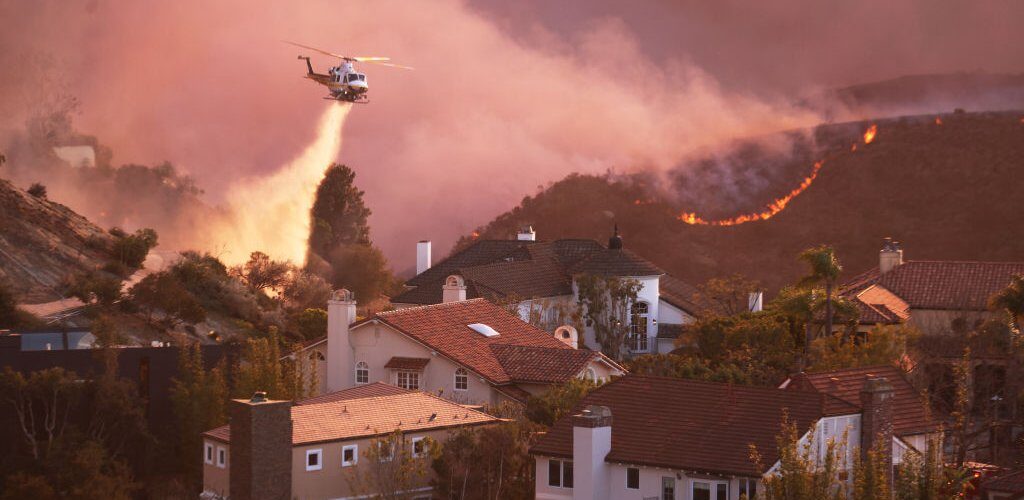LA Fires Hasten an ‘Uninsurable Future’
January 9, 2025

- AmeriLife To Acquire Crump Life Insurance Services
- Colorado lawmaker to introduce bills aimed at addressing availability, affordability of homeowners insurance
- Strate Insurance merges with Main Street Insurance
- Stephens Insurance Names New CEO, Chief Strategy Officer
- More Coloradans reveal insurance company incorrectly billed them for “hidden” drivers
Insurance companies were worried about many of the homes in the Pacific Palisades neighborhood of Los Angeles long before this week’s devastating wildfire burned through the area, ravaging homes and forcing evacuations. The Palisades, because of its location next to the brush-heavy Santa Monica Mountains and the high value of its homes, was too vulnerable to fires to insure at permissible rates without the companies losing money. Insurers including State Farm, which dropped nearly 70% of policyholders in Pacific Palisades in July 2024, refused to offer new insurance plans or renew old ones.
Bạn đang xem: LA Fires Hasten an ‘Uninsurable Future’
As a result, many homeowners were forced to obtain coverage from the state’s insurer of last resort, the California Fair Access to Insurance Requirements (CA FAIR) Plan, which covered 1,430 homeowners in the Pacific Palisades zip code of 90272 in September 2024, an 85% increase from 2023. The FAIR plan insures homes against fire but has higher premiums than traditional home insurance and only covers up to $3 million in damages for residential properties.
Like many other insurers of last resort in the 33 other states with this type of system, the California FAIR Plan is buckling under the weight of natural disasters worsened by climate change. “I’m concerned that we’re one bad fire season away from complete insolvency,” said Jim Wood, then a California Assemblyman, at a March hearing in which CA Fair Plan President Victoria Roach explained that it had just $200 million of cash on hand, with $450 billion of exposure in the state.
Read More: The Conditions That Led To the Unprecedented Los Angeles Fires.
Xem thêm : Op-ed | One way health insurance companies seem to profit off patients over the phone
That bad fire season is now here. As infernos burn across Los Angeles County, torching at least 28,000 acres, analysts at Accuweather estimate losses could reach $52 to $57 billion. It is a blow to the hundreds of insurers operating in California, but a particular challenge for the state’s insurer of last resort. And its predicament highlights the precarity of the home insurance market, in California and nationally. Due to an increased risk of fires, floods, convective storms, hurricanes, and other national disasters, it doesn’t make financial sense for insurers to offer plans to some people. In 2023, insurers lost money on homeowner coverage in 18 states, up from 12 states five years ago, according to an analysis by the New York Times.
About the same number of states are seeing both increases in home insurance prices as well as increases in non-renewals of insurance, according to Dave Jones, the former insurance commissioner of California and now director of the Climate Risk Initiative at the University of California, Berkeley School of Law. “In the long term, we’re not doing enough to deal with the underlying driver, which is fossil fuels and greenhouse gas emissions, so we’re going to continue to see insurance unavailability throughout the U.S.,” says Jones. “We are marching steadily towards an uninsurable future in this country.”
As insurers drop policyholders, homeowners turn to insurers of last resort—in the Southeast, they’re often called Beach and Windstorm Plans—which can’t really afford to insure them either. Yet more states are creating these plans to bolster private property insurance markets. Nationwide, the number of FAIR Plan insurance policies nearly doubled between 2018 and 2023, rising to 2.7 million, according to data from AM Best, a company that rates the financial strength of insurers. The California FAIR Plan alone saw its exposure grow nine-fold over the past six years.
“The plan of last resort,” says Benjamin Collier, a professor of risk management and insurance at Temple University in Philadelphia, “ is becoming the de facto insurance in the state.”
The fate of the California FAIR Plan affects everyone in the nation’s most populous state. If it doesn’t have enough money to cover its claims, every policyholder in the state ends up paying more. Insurers are responsible for covering the first billion dollars of claims in California, but then the responsibility goes to every insurance policyholder in the state—who are responsible for additional assessed charges. Essentially, everyone has to pay to reimburse people whose homes lie in high-risk areas.
Xem thêm : Best Cheap Pet Insurance Of 2025
Florida is a case in point: when Citizens, the state-run insurer of last resort, can’t pay out claims, policyholders must pay the bill, which added up to a “Hurricane Tax” of hundreds of dollars per household after Hurricane Ian hit the Atlantic Coast near Cape Canaveral in 2022, causing $113 billion in damages.
The way FAIR Plans work “is really a symptom of the broader insurance market failing,” says David Marlett, managing director of the Brantley Risk and Insurance Center at Appalachian State University. “It’s a horrible system.”
Read More: How to Help Victims of the Los Angeles Wildfires.
In some ways, it’s useful for people to be priced out of insurance and have to turn to FAIR Plans, which are more expensive than regular insurance and don’t cover as much loss, says Collier, the Temple professor. The insurance market is one way of signaling where people should and shouldn’t live; more expensive plans may help guide people from high-risk areas. But as the insurance math becomes unworkable in wider bigger swathes of the country, FAIR Plans won’t be a tenable solution. “We need to be dramatically rethinking how homeowners’ insurance works and what it covers,” says Collier.
One potential fix would be for the federal government to offer to provide insurance (called reinsurance) for FAIR Plans, essentially backstopping them if they don’t have enough money to pay out claims, says Jones, the former insurance commissioner. That would also help FAIR Plans save money on buying insurance from the private markets. Jones also suggests creating an Obamacare-style marketplace for home insurance, where the government can subsidize low or moderate-income households buying insurance.
What won’t work, experts say, is continuing with the same system and hoping that climate risk just goes away. “Insurers are not magicians,” Jones says. “The risks of loss are rising through climate change, and insurers can’t just wave a magic wand and make them go away.”
Nguồn: https://propertytax.pics
Danh mục: News
